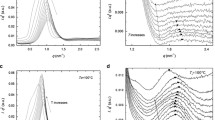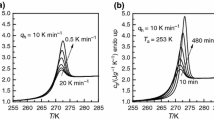Abstract
Gels of dibenzylidene sorbitol (DBS) in poly(propylene oxide) (PPO) show an increase in viscosity in a certain temperature range during melting. This so-called thermo-thickening behaviour is quite uncommon. In the few already known cases, the thermo-thickening is caused by simple thermodynamic processes that result in the formation of structures. We show for the first time that, in the case of PPO-DBS gels, experimental parameters like sample volume and heating rate play an important role and indicate non-equilibrium behaviour. It turns out that the peculiar thermo-thickening is the result of a reformation of the fibre network structure, which was destroyed earlier due to a strong temperature gradient within the sample.





Similar content being viewed by others
References
Bokias G, Hourdet D, Iliopoulos I, Staikos G, Audebert R (1997) Hydrophobic interactions of poly(N-isopropylacrylamide) with hydrophobically modified poly(sodium acrylate) in aqueous solutions. Macromolecules 30:8293–8297
Cohn D, Sosnik A, Levy A (2003) Improved reverse thermo-responsive polymeric systems. Biomaterials 24:3707–3714
Davies TS, Ketner AM, Raghavan SR (2006) Self-assembly of surfactant vesicles that transform into viscoelastic wormlike micelles upon heating. J Am Chem Soc 128:6669–6675
Dobreva T, López-Majada JM, Pereña JM, Pérez E, Benavente R (2008) Nonisothermal melt-crystallization kinetics of isotactic polypropylene synthesized with a metallocene catalyst and compounded with different quantities of an nucleator. J Appl Polym Sci 109:1338–1349
Fahrlaender M, Fuchs K, Friedrich C (2000) Rheological properties of dibenzylidene sorbitol networks in poly(propylene oxide) matrices. J Rheol 44:1103–1119
Fraessdorf W, Fahrlaender M, Fuchs K, Friedrich C (2003) Thermorheological properties of self-assembled dibenzylidene sorbitol structures in various polymer matrices: determination and prediction of characteristic temperatures. J Rheol 47:1445–1454
Ilzhoefer JR, Spontak RJ (1995) Effect of polymer composition on the morphology of self-assembled dibenzylidene sorbitol. Langmuir 11:3288–3291
Ilzhoefer JR, Broom BC, Nepa SM, Vogler EA, Khan SA, Spontak RJ (1995) Evidence of hierarchical order in an amphiphilic graft terpolymer gel. J Phys Chem 99:12069–12071
Jin Y, Hiltner A, Baer E (2007) Effect of a sorbitol nucleating agent on fractionated crystallization of polypropylene droplets. J Polym Sci, Part B: Polym Phys 45:1788–1797
Kalur GC, Frounfelker BD, Cipriano BH, Norman AI, Raghavan SR (2005) Viscosity increase with temperature in cationic surfactant solutions due to the growth of wormlike micelles. Langmuir 21:10998–11004
Kühne M, Friedrich C (2009) Nonlinear rheological properties and stability of dibenzylidene sorbitol fiber networks in poly(propylene oxide). Rheol Acta 48:1–9
MacKintosh FC, Kas J, Janmey PA (1995) Elasticity of semiflexible biopolymer networks. Phys Rev Lett 75:4425–4428
Mercurio DJ, Spontak RJ (2001) Morphological characteristics of 1,3:2,4-dibenzylidene sorbitol/poly(propylene glycol) organogels. J Phys Chem B 105:2091–2098
Mercurio DJ, Khan SA, Spontak RJ (2001) Dynamic rheological behavior of DBS-induced poly(propylene glycol) physical gels. Rheol Acta 40:30–38
Nunez CN, Whitfield K, Mercuriop JR, Ilzhoefer JR, Spontak RJ, Kahn SA (1996) Effect of molecular architecture on DBS-induced block copolymer gels: a rheological study. Macromol Symp 106:275–286
Terech P, Weiss RG (1997) Low molecular mass gelators of organic liquids and the properties of their gels. Chem Rev 97:3133–3159
Vasile C, Bumbu GG, Mylonas I, Bokias G, Staikos G (2004) Thermoresponsive behaviour in aqueous solution of poly(maleic acid-alt-vinyl acetate) grafted with poly(N-isopropylacrylamide). Polym Int 53:1176–1179
Watase M, Nakatani Y, Itagaki H (1999) On the origin of the formation and stability of physical gels of di-O-benzylidene-D-sorbitol. J Phys Chem B 103:2366–2373
Wilder EA, Hall CK, Khan SA, Spontak RJ (2002) Molecular self-organization and gelation efficacy of dibenzylidene sorbitol: an overview. Rec Res Dev Mat Sci 3:93–115
Yamasaki S, Tsutsumi H (1994) Microscopic studies of 1,3-2,4-di-o-benzylidene-d-sorbitol in ethylene-glycol. Bull Chem Soc Jpn 67:906–911. doi:10.1246/bcsj.67.906
Yamasaki S, Tsutsumi H (1995) The Dependence of the polarity of solvents on 1,3/2,4-di-o-benzylidene-d-sorbitol gel. Bull Chem Soc Jpn 68:123–127. doi:10.1246/bcsj.68.123
Zhao GQ, Khin CC, Chen SB, Chen BH (2005) Nonionic surfactant and temperature effects on the viscosity of hydrophobically modified hydroxyethyl cellulose solutions. J Phys Chem B 109:14198–14204
Acknowledgement
The authors thank the Deutsche Forschungsgemeinschaft for funding this work through the Sonderforschungsbereich 428.
Author information
Authors and Affiliations
Corresponding author
Appendix
Appendix
As shown by Kühne and Friedrich (2009), DBS-PPO gels can be considered as a network of semiflexible DBS fibres in a PPO matrix.
Following MacKintosh et al. (1995), the elastic modulus of such a network can be explained as`
where κ is the bending modulus of the fibres, L M is the mesh size, and L e is the entanglement length. For such networks
and these lengths are assumed to be almost temperature independent, so Eq. 1 can be written as
The temperature dependence of the mesh size determines the temperature dependence of the sample’s density. Due to the fact that this density is almost temperature independent, this assumptions seem to be reasonable.
The bending modulus of such fibres is itself temperature dependent, following
in which E(T) is the Young modulus of the fibre and I its moment of inertia. We assume as for many crystalline materials that the Young modulus scales with
Inserting Eqs. 4 and 5 into Eq. 3 leads to the following scaling of the elastic modulus:
the observed temperature dependence.
Rights and permissions
About this article
Cite this article
Kühne, M., Wurth, J. & Friedrich, C. Thermo-thickening during melting of dibenzylidene sorbitol fibre networks. Rheol Acta 49, 315–321 (2010). https://doi.org/10.1007/s00397-009-0425-1
Received:
Accepted:
Published:
Issue Date:
DOI: https://doi.org/10.1007/s00397-009-0425-1




